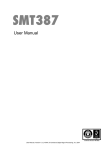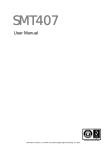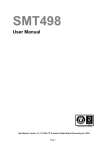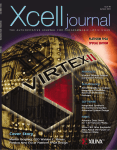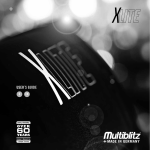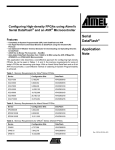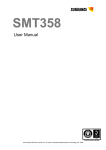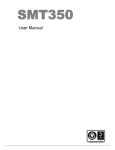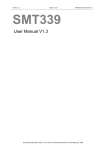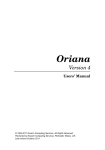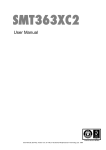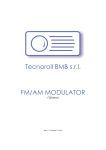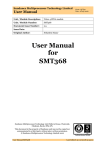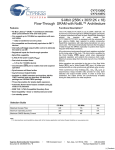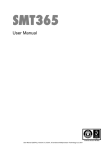Download SMT398 User Manual
Transcript
SMT398
User Manual
Version 1.2.0
Page 2 of 52
SMT398 User Manual
Revision History
Date
Comments
Engineer
Version
18.07.03
First released version
E.P
1.0.0
22.08.03
TIM CONFIG signal feature described
E.P
1.1.0
27.08.03
Minor corrections
E.P
1.1.1
05.09.03
Detailed description of FPGA I/Os constraint E.P
file signal names.
1.1.2
14.10.03
Addition of SHB connector names A, B ,C ,D.
E.P
1.1.3
28.10.03
Addition of figure 12 and details about pInout E.P
for SHB connectors in basic or full
configuration
1.1.4
02.11.03
Minor clarification about the ZBTRAM Memory E.P
banks available depending on the board
configuration and speed grade
1.1.5
27.07.04
Update of the Reset Control section to be more E.P
explicit about the various ways of handling
reset control.
1.1.6
01.12.04
Removed
statement
saying
that
the E.P
FPGAfullconfig and loadbitstream code can be
recompiled for any C6x-processor-board to use
under Code Composer Studio and/or 3L
Diamond.
1.1.7
12.01.05
Block Diagram update: removed wrong CPLD E.P
description (Timer)
1.1.8
20.05.05
Added: Start and End keys values
SM
1.1.9
17.10.05
Changed: Hyperlink for ZBTRAM datasheets
SM
1.2.0
Version 1.2.0
Page 3 of 52
SMT398 User Manual
Table of Contents
Revision History.......................................................................................................... 2
Table of Contents ....................................................................................................... 3
Table of Figures.......................................................................................................... 6
Table of Tables........................................................................................................... 6
Physical Properties..................................................................................................... 8
Introduction................................................................................................................. 9
Related Documents ................................................................................................ 9
Block Diagram ............................................................................................................ 9
Mechanical Interface: TIM Standard......................................................................... 10
SMT398 Support ...................................................................................................... 10
SMT398 Installation.................................................................................................. 10
SMT398 Alone ...................................................................................................... 10
SMT398 + DSP TIM.............................................................................................. 12
FPGA Configuration ................................................................................................. 13
Electrical Interface .................................................................................................... 13
The service CPLD ................................................................................................. 13
CPLD Functions ................................................................................................ 14
Virtex II Bitstream Format.................................................................................. 19
Bitstream Re-formatting..................................................................................... 20
CPLD code versions.......................................................................................... 20
FPGA .................................................................................................................... 20
FPGA in system programming .......................................................................... 22
JTAG/Boundary Scan........................................................................................ 23
Configuring with MultiLINX ................................................................................ 24
FPGA Readback and Partial reconfiguration..................................................... 24
Memory ................................................................................................................. 25
Pipelined ZBTRAM ............................................................................................ 25
Constraints File Signal Names .......................................................................... 27
QDR (Quad Data Rate) ..................................................................................... 27
Constraints File Signal Names .......................................................................... 29
Comports .............................................................................................................. 29
Version 1.2.0
Page 4 of 52
SMT398 User Manual
Constraints File signal Names........................................................................... 31
SHB ...................................................................................................................... 31
SHB Connector ................................................................................................. 31
SHB Cable Assembly ........................................................................................ 33
SHB Inter Modules solutions ............................................................................. 33
Half Word Interface (16-bit SHB Interface) ........................................................ 33
Constraint File Signal Names ............................................................................ 34
Global bus............................................................................................................. 36
Constraints File Signals Names ........................................................................ 37
Clocks ................................................................................................................... 37
Constraints file signal Names ............................................................................ 38
Power Supplies ..................................................................................................... 38
DC/DC Converter .............................................................................................. 39
Linear Voltage regulator .................................................................................... 40
Fan .................................................................................................................... 40
Power Consumption.............................................................................................. 40
Verification Procedures ............................................................................................ 41
Review Procedures .................................................................................................. 41
Validation Procedures .............................................................................................. 41
FPGA Constraint File general Information ................................................................ 41
Ordering information:................................................................................................ 43
Full configuration................................................................................................... 43
Basic configuration................................................................................................ 44
Memories........................................................................................................... 44
SHBs ................................................................................................................. 44
Comports........................................................................................................... 44
Global Bus......................................................................................................... 45
External Clock ................................................................................................... 45
PCB Layout Details .................................................................................................. 46
Components placement ........................................................................................ 46
Headers Pinout......................................................................................................... 48
SHB Header.......................................................................................................... 48
SHB Pinout (LVTTL only).(J8-J9-J10-11) .......................................................... 49
Version 1.2.0
Page 5 of 52
SMT398 User Manual
JTAG/Multilinx headers ......................................................................................... 50
JTAG/Boundary scan pinout (J13) .................................................................... 50
MultiLINX SelectMap Pin Descriptions (J12-J13) .............................................. 51
Safety ....................................................................................................................... 52
EMC ......................................................................................................................... 52
Version 1.2.0
Page 6 of 52
SMT398 User Manual
Table of Figures
Figure 1:SMT398 Block Diagram .............................................................................................9
Figure 2: FPGA configuration in SelectMap mode using CPLD.............................................14
Figure 3: Comport word Byte order ........................................................................................15
Figure 4: CPLD state machine ...............................................................................................16
Figure 5: V II Configuration Bitstream Word Format ..............................................................20
Figure 6: JTAG Chain on the SMT398 ...................................................................................23
Figure 7:SMT398 ZBT Memory Banks arrangement .............................................................26
Figure 8: ZBT Constraints file signal names ..........................................................................27
Figure 9:SMT398 QDR Width expansion arrangement..........................................................28
Figure 10: QDR Constraints file signal names .......................................................................29
Figure 11:SMT398 Comports connections.............................................................................30
Figure 12: Comport Constraints file signal name ...................................................................31
Figure 13: SHB Connector .....................................................................................................32
Figure 14: SHB constraints file control signals names. ..........................................................35
Figure 15: SHB constraints file data signals names...............................................................35
Figure 16: SHB constraints file User pins signals names.......................................................36
Figure 17: Global Bus constraints file signal names. .............................................................37
Figure 18: DC/DC converter dimensions (in inches) ..............................................................39
Figure 19:SMT398 Components placement-Top view ...........................................................46
Figure 20: SMT398 Components placement-Bottom view.....................................................47
Figure 21: Top View QSH 30 .................................................................................................48
Figure 22: Top View of JTAG/Multilinx headers .....................................................................50
Table of Tables
Table 1: FPGA Choices..........................................................................................................21
Table 2: ZBTRAM sizes .........................................................................................................26
Table 3: QDR RAM sizes .......................................................................................................28
Table 4: External clock specification ......................................................................................38
Table 5: powering the devices................................................................................................39
Table 6: Duplicate pins...........................................................................................................42
Table 7: Virtex II, ZBT/QDR combinations in FULL configuration ..........................................44
Table 8: Virtex II, ZBT combinations in BASIC configuration .................................................45
Table 9: SHB interfaces table.................................................................................................49
Table 10: Connector J13-JTAG Header.................................................................................50
Version 1.2.0
Page 7 of 52
SMT398 User Manual
Table 11: Connector J13-Flying Lead Set #1.........................................................................51
Table 12: Connector J12 Flying Lead Sets 3&4.....................................................................52
Version 1.2.0
Page 8 of 52
SMT398 User Manual
Physical Properties
Dimensions
See Physical specifications of TI TIM specification &
user’s guide
Weight
Varies in function of board configuration
Supply Voltages
See Power Supplies
Supply Current
See Power Supplies
Version 1.2.0
Page 9 of 52
SMT398 User Manual
Introduction
Related Documents
SUNDANCE SHB specification
Sundance SDB specification.
TI TIM specification & user’s guide.
Samtec QSH Catalogue page
SMT6500 help file: FPGA support package
Block Diagram
SelectMAP Header
JTAG Header
Interrupts&Reset
5 I/O pins
2x Comm-Ports/SDL
24 I/O pins
J1 Top Primary TIM
Connector
Comm-Port 0 & 3
On-board
Oscillator
Sundance Digital Bus
or Sundance High-speed Bus
connector x4
16 I/O pins
External Clock
FPGA
240 I/O Pins
Virtex-II FF896/1152
XC2V1000 - XC2V8000
432 to 824 I/O Pins
1.5V Core
1.5V/3.3V I/O
Global Bus
78 I/O pins
4 LEDs or
4 I/O pins
J3 Global Expansion
Connector
Figure 1:SMT398 Block Diagram
Clk
120 I/O pins; 16-bit data
2, 4 Mbytes QDR-SRAM
2x (1 or 2Mx18)
183 I/O pins; 16-bit data
2,4,8 or 16Mbytes ZBTRAM as SMT358
4x Comm-Port/SDL
48 I/O pins
Xilinx XC95288 CS280 CPLD
on Comm-Port #0 and #3
and Config&Reset
J2 Bottom Primary TIM
Connector
4xComm-Port/SDL 1;2;4 & 5
Version 1.2.0
Page 10 of 52
SMT398 User Manual
Mechanical Interface: TIM Standard
This module conforms to the TIM standard (Texas Instrument Module, See TI TIM
specification & user’s guide.) for single width modules.
It sits on a carrier board.
The carrier board provides power, Ground, communication links (Comport links)
between all the modules fitted and a pathway to the host, for a non stand-alone
system.
The SMT398 requires an additional 3.3V power supply (as present on all Sundance
TIM carrier boards), which must be provided by the two diagonally opposite mounting
holes.
SMT398 Support
The SMT398 is supported by the SMT6500 software package available from
SUNDANCE. Please register on SUNDANCE Support Forum if not yet registered.
Then enter your company’s forum and you can request the SMT6500 from there.
SMT398 Installation
Do NOT connect any external TTL (5v) signals to the SMT398 I/Os as the FPGA
is NOT 5v compliant. This implies that the Comports and global bus lines of
the carrier board MUST be LVTTL and that any device driving signals on the
SHB connectors must drive at LVTTL (3.3v).
Two types of configuration are described here; nevertheless, you shouldn’t be
restricted and should consult Sundance if your system architecture differs.
SMT398 Alone
You can fit the SMT398 on its own, on the first TIM site of one of Sundance’s 3.3v
compatible carrier boards plugged in a host computer (PC, PCI, VME carrier etc…),
like SMT310Q, SMT328, SMT300 etc…)
Please, follow these steps to install the SMT398 module on a Host system:
1. Remove the carrier board from the host system.
2. Place the SMT398 module on the first TIM site. This TIM site communicates
with the host. (See your carrier board User Manual.) This allows you to use
Global Bus and Comport 3 to communicate with the host.
Version 1.2.0
Page 11 of 52
SMT398 User Manual
3. Make sure that the board is firmly seated, and then provide the 3.3V to the
board by screwing the SMT398 on the two main mounting holes with the bolts
and screws provided with the board.
4. Connect the SHB links if required by your application.
5. Replace the carrier board in the host system or power on for a stand-alone
carrier.
Version 1.2.0
Page 12 of 52
SMT398 User Manual
SMT398 + DSP TIM
You can fit the SMT398 coupled with a DSP module on any of Sundance carrier
boards: Stand alones or plugged in a Host.
The DSP module can then be used to provide the SMT398 FPGA configuration
bitstream and to communicate with the host.
Please, follow these steps to install the SMT398 module and the DSP TIM on a
carrier:
1. Remove the carrier board from the host system or turn the power off for a standalone carrier.
2. Place the SMT398 module onto one of the TIM sites on the carrier board.
•
Preferably, fit the DSP TIM on the first TIM site. This TIM site
communicates with the host. (See your carrier board User Manual.).
This allows the processor board to handle the interactions with the Host
by software instead of having to implement a communication interface
in the SMT398 FPGA. (Global Bus interface or Comport interface on
Comport 3).
•
Fit the Comport communication links between the DSP TIM and the
SMT398 respecting the rules on polarity at reset. (See your carrier
board User Manual.)
•
To configure the SMT398 FPGA using the DSP TIM, then you need a
link between the 2 modules: Comport 3 of the SMT398 MUST be
connected to one of the transmit Comport at Reset (Comport 0,1 or 2)
available on the DSP TIM.
3. Make sure that the board is firmly seated, and then provide the 3.3V to the board
by screwing the SMT398 on the two main mounting holes with the bolts and
screws provided with the board.
4. Connect the SHB links if required by your application.
5. Replace the carrier board in the host system or power on for a stand-alone
carrier.
Version 1.2.0
Page 13 of 52
SMT398 User Manual
FPGA Configuration
The FPGA can be configured 2 different ways:
•
Using Comport 3 to provide the bitstream. (See The service CPLD)
•
Using the on-board JTAG header and Xilinx JTAG programming tools. (See
FPGA in system programming)
At power up the FPGA is not configured.
LED L5 (See Figure 19:SMT398 Components placement-Top view, bottom right
hand corner of the picture) will be lit upon FPGA configuration.
Electrical Interface
The service CPLD
The CPLD allows for FPGA configuration in slave SelectMap mode.
At power up or after a Reset of the SMT398, the CPLD is configured and
implements a Comport link receiver on Comport 3.
The CPLD is connected to Comport number 3 of the SMT398 TIM connector.
Consequently, the Comport on the other end of the link must be configured as
transmitter at power-up or after reset, i.e. Comport channels 0, 1, or 2.
The typical SMT398 user does not need an in depth understanding of the
configuration sequence and of the Virtex II. However, for the purpose of debugging
and designing for the SMT398 an overview of the necessary configuration protocol
and bitstream formatting is recommended.
Therefore, this section describes the CPLD functions, the Virtex II bitstream format
and the necessary bitstream re-formatting when downloading the bitstream to the
FPGA via CPLD + Comport 3.
Figure 2: FPGA configuration in SelectMap mode using CPLD provides waveforms to
illustrate the descriptions below.
Version 1.2.0
Page 14 of 52
SMT398 User Manual
Figure 2: FPGA configuration in SelectMap mode using CPLD
CPLD Functions
•
Decode Commands coming on Comport 3.
•
To Implement a Comport Receiver on Comport 3 after Reset or at Power up.
•
Configure FPGA.
•
Reset FPGA.
Version 1.2.0
Page 15 of 52
SMT398 User Manual
Decode Commands
At power up, after a TIM global Reset, or once the FPGA configuration process is
over, the CPLD reads any word coming on its Comport.
If a received word cannot be recognized as a command, the word is read completely
but ignored. The CPLD recognizes the following two commands:
•
STARTKEY (0xBCBCBCBC)
•
ENDKEY (0xBCBCBC00)
Comport Receiver
At power up or after a TIM global Reset, the CPLD takes control of Comport 3.
Once the ENDKEY command is received, the CPLD releases Comport 3.
The Comport communication is performed in 32-bit words, where each word consists
of four consecutive bytes. The Comport protocol transmits words starting with the
least-significant byte (LSByte), i.e. byte0, as shown in Figure 3: Comport word Byte
order, and 1 byte at a time.
Byte3
31
Byte2
24 23
Byte1
16 15
Byte0
8
7
0
D31 D30 D29 D28 D27 D26 D25 D24 D23 D22 D21 D20 D19 D18 D17 D16 D15 D14 D13 D12 D11 D10 D9 D8 D7 D6 D5 D4 D3 D2 D1 D0
Figure 3: Comport word Byte order
Configure FPGA
The signals INITn and DONE are CPLD inputs, the other one are CPLD outputs that
the CPLD drives to configure the FPGA.
On reception of the STARTKEY command the CPLD clears the FPGA configuration
memory by asserting the PROGRAMn pin low. On INITn going low, the CPLD brings
PROGRAMn high and waits for INITn to come back high before starting the FPGA
configuration.
Afterwards, the CPLD asserts CSn and WRITEn low for the rest of the configuration
process.
The CPLD pulses high CCLK to loads in the FPGA any new byte present on the
Comport by.
Version 1.2.0
Page 16 of 52
SMT398 User Manual
The CPLD does not implement any operation on the bitstream and passes it straight
through to the FPGA once the STARTKEY has been decoded and until the ENDKEY
is decoded.
Once the FPGA DONE pin has gone high, LED L5 (See Figure 19:SMT398
Components placement-Top view, bottom right hand corner of the picture) becomes
on, indicating that the FPGA configured.
The CPLD disables the SelectMap interface and waits for the ENDKEY command on
Comport3.
Once the ENDKEY command is received, the CPLD releases Comport 3.
Reset Control
TIM Reset
or TIM Config
INIT
STARTKEY Received
FPGA Configured and
ENDKEY Received
CONFIG
IDLE
FPGA Configured
and ENDKEY Received
Figure 4: CPLD state machine
Version 1.2.0
Page 17 of 52
SMT398 User Manual
TIM Global Reset
The CPLD is connected to a TIM global Reset signal provided to the SMT398 via its
TIM connector J4 pin 30. (See Figure 19:SMT398 Components placement-Top view).
The TIM global Reset signal is also available for the FPGA but the CPLD provides
another signal called FPGAReset_In that offers a better Reset control over the
FPGA.
At power up or on reception of a low TIM global Reset pulse, the CPLD drives the
FPGAReset_In signal low and keeps it low.
When the ENDKEY has been received, the CPLD drives FPGAReset_in high.
I recommend that you use FPGAReset_In for the Global Reset signal of your FPGA
designs.
In this manner, you can control your FPGA design Reset activity and you will also
avoid possible conflicts on Comport 3 if your FPGA design implements it.
The Reset control is operated by the CPLD line FPGAReset_In.
DO NOT use TIM GLOBAL Reset unless you have a very specific need for your
application.
TIM CONFIG
A TIM CONFIG signal coming from the TIM connector J4 pin 74. (See Figure
19:SMT398 Components placement-Top view and Figure 11:SMT398 Comports
connections) is available to the CPLD.
CONFIG falling has the same effect on the SMT398 CPLD as a TIM global Reset
pulse.
On detection of a falling edge on the CONFIG line, the CPLD drives the
FPGAReset_In signal low and keeps it low.
CONFIG provides a means of reprogramming the FPGA without having to drive the
TIM Global Reset signal.
Therefore any other modules sensitive to the TIM global Reset signal will not be
affected and can keep running their application.
CONFIG is driven from another TIM site on the carrier board, for instance, from a
DSP module running an application. (See the SMT6400 help file for information on
the DSP TIM CONFIG signal).
Writing ‘1’ to the DSP CONFIG bit in the config register tristates the line (pull-ups on
the carrier board pull CONFIG high)
Writing ‘0’ to the DSP CONFIG bit in the config register makes the CONFIG signal go
low.
Version 1.2.0
Page 18 of 52
SMT398 User Manual
After a Global Reset pulse, a DSP module drives CONFIG low and keeps it low by
default.
After Reset and loading of the DSP application, CONFIG can be driven the following
way:
#include “SMT3xx.h”
#define CONFIG_BIT 1<<6
int main()
{
*CONFIG |= CONFIG_BIT; //tristates CONFIG (Pull-ups on the carrier board pull CONFIG high)
*CONFIG &= (UINT32)~CONFIG_BIT;//CONFIG is driven low
//delay while the FPGA is configured
*CONFIG |= CONFIG_BIT;
}
This feature can be interesting in systems where:
• The FPGA needs to implement multiple functions spread in different
bitstreams that are needed at different stages of the application.
• The system needs to keep running and can’t be interrupted by a global Reset
pulse when the SMT398 FPGA needs to be configured with a new bitstream.
• The FPGA needs to be kept in reset BUT NOT reprogrammed.
o Config low Pulse: the CPLD drives the FPGAReset_In signal low and
keeps it low.
o ENDKEY: The CPLD drives the FPGAReset_In signal high.
Version 1.2.0
Page 19 of 52
SMT398 User Manual
Notes:
• TIM CONFIG is only available on SMT398 v3. The SMT398 version is written
on TOP of the board (See Figure 19:SMT398 Components placement-Top
view).
• TIM CONFIG needs CPLD code version 2.1 or above (Written on a sticker on
the CPLD. (See Figure 19:SMT398 Components placement-Top view).
• The Comport3 is reserved for the CPLD and cannot be made available to the
FPGA.
• CONFIG needs switch SW1 position 8 to be ON. (See Figure 20: SMT398
Components placement-Bottom view)
• If you have more than one DSP module on a carrier and that you want to use
the CONFIG line, you must decide which TIM is going to be the master and
have the other DSP modules to tri-state their CONFIG line at the start of their
application by writing ‘1’ to the corresponding register bit. (See the SMT6400
help file for information on the DSP TIM CONFIG signal).
Summary:
The Reset level on the SMT398 FPGA is active low.
The reset line to be used is FPGAReset_in on pad AM20 for FPGAs in the big
package (FF1152) and AK18 for the smaller package FPGAs.
Virtex II Bitstream Format
The Virtex II SelectMap interface is an 8-bit interface on the device with data pins
labeled D[7:0]. The configuration bitstreams can be written eight bits per clock cycle.
The Virtex II configuration bitstreams generated by BitGen (.bit files) contain a mix of
commands and data on 32 bit word boundaries, shown in Xilinx application note 138
page 20. This format assumes D0 is considered the MSBit as shown Figure 5: V II
Configuration Bitstream Word Format.
Version 1.2.0
Page 20 of 52
Byte0
31
Byte1
24 23
SMT398 User Manual
Byte2
16 15
Byte3
8
7
0
D0 D1 D2 D3 D4 D5 D6 D7 D8 D9 D10 D11 D12 D13 D14 D15 D16 D17 D18 D19 D20 D21 D22 D23 D24 D25 D26 D27 D28 D29 D30 D31
Figure 5: V II Configuration Bitstream Word Format
As a result, to be able to download the bitstream to the FPGA using Comport3 +
CPLD, the Virtex II configuration bitstream must be re-formatted to match the
Comport word standard.
Bitstream Re-formatting
The re-formatting consists in inverting the bits in a byte and the bytes in a 32-bit
word.
Further, the .bit files contain a header section before the pad word and
synchronization word. The download function FPGAFullConfiguration() from the
SMT6500 package searches for the synchronization sequence and skips the header.
CPLD code versions
•
V1.0: Initial release that only receives the bitstream and configures the FPGA.
FPGAResetn is NOT implemented and Comport 3 is NOT released once the
FPGA is configured.
•
V2.0 Indicated on a sticker on the CPLD. The CPLD implements the functions
described above except TIM CONFIG.
•
V2.1 Indicated on a sticker on the CPLD. V2.0 + the CPLD implements the
reconfiguration feature described in TIM CONFIG.
FPGA
The module can be fitted with a XC2V1000, XC2V1500, XC2V2000, XC2V3000,
XC2V4000, XC2V6000 or XC2V8000.
The FPGA comes in two pinout/footprint compatible packages: flip-chip FF896 and
FF1152.
The choice of FPGA will be price/performance driven. The following table shows the
main FPGA characteristics.
The choice of the FPGA also determines which board architecture you will get
(amount of logic available, speed, number and type of I/Os, on-board Memory size
and type). For a complete list of the different board architectures, please consult: 0
Ordering information:
Version 1.2.0
Page 21 of 52
SMT398 User Manual
This Xilinx Virtex II, is responsible for the provision of up to 4 SHBs, up to 6
Comports, the global bus and QDR/ZBT memory banks (In FULL configuration, see 0
Ordering information:)
Device
Syste
m
gates
CLB(1 CLB = 4 slices = Max 128
bits)
Array
Row
Col
x
Slices
SelectRAM Blocks
Maximum
distribute Multiplie
d
RAM r
Kbits
blocks
18-Kbit
Block
Max RAM DCM
s
(Kbits)
XC2V1000
1M
40x32
5,120
160
40
40
720
8
XC2V1500
1.5M
48x40
7,680
240
48
48
864
8
XC2V2000
2M
56x48
10,752
336
56
56
1,008
8
XC2V3000
3M
64x56
14,336
448
96
96
1,728
12
XC2V4000
4M
80x72
23,040
720
120
120
2,160
12
XC2V6000
6M
96x88
33,792
1,056
144
144
2,592
12
XC2V8000
8M
112x104
46,592
1,456
168
168
3,024
12
Table 1: FPGA Choices
The Xilinx FPGA is configured from one of several modes:
Slave SelectMAP.
JTAG/Boundary scan
And from one of several sources:
Comport 3 (Using Slave SelectMAP)
Parallel cable III-IV (Using JTAG)
MultiLINX cable. (Using JTAG or Slave SelectMAP)
At power up the FPGA is not configured.
LED L5 (See Figure 19:SMT398 Components placement-Top view, bottom right
hand corner of the picture) will be lit upon FPGA configuration.
Version 1.2.0
Page 22 of 52
SMT398 User Manual
FPGA in system programming
The factory default for the FPGA configuration mode is using Slave SelectMAP mode
and the Comport3.
Configuring the FPGA from Comport 3 allows NOT USING any JTAG cables.
Having a direct link enhances debugging and testing, and therefore reduces the
product’s time to market.
Once the design is complete, the configuration data can be stored on disk and then
loaded each time the system powers up or is reset.
The configuration data can also be downloaded into a DSP TIM module external
memory along with the DSP application. See TIM CONFIG.
The bitstream is presented on Comport3 and the CPLD provides the mechanism to
deliver it quickly to the Virtex-II device using the Slave SelectMAP mode.
Then, the configuration cycle can be transparent to the end user.
After configuration the Comport3 can be available to the FPGA for data transfers if
the Virtex II is XC2V3000 or above and if your CPLD design version allows it. See
CPLD code versions
SMT398 Alone
Host software can be developed to communicate with the SMT398.
See SMT6025 User Manual on Sundance Web site for more information on how to
develop Host applications for Sundance Hardware.
The host Software application BitstreamLd.exe provided in the SMT6500 package is
compiled for Windows NT/2000/XP.
It allows downloading a bitstream to the SMT398 FPGA by accessing Comport 3 of
the carrier board’s first site.
SMT398 + DSP TIM
The DSP software routines provided are the download functions LoadBitstream() and
FPGAFullConfiguration().
•
LoadBitstream():This function reads a bit file from your local HD and stores it
on the DSP board.
•
FPGAFullConfiguration(): The FPGA is configured with data from a .bit file
stored on your DSP board.
These functions were developped using 3L Diamond’s high level Comport link
functions and will NOT work under CCStudio. You will have to develop your own
functions to work under CCStudio.
Version 1.2.0
Page 23 of 52
SMT398 User Manual
•
Bit2Asm.exe. This stand alone executable formats a bit file into a Texas
instrument’s asm file. Then you can embed it in your application’s object file at
linking time. As a result, the FPGA bitstream is downloaded with the
application into the DSP module’s memory which provides a faster FPGA
configuration process than the standard way. See TIM CONFIG.
•
You can find detailed information about the DSP software routines in:
Application note about bitstream download software.pdf
JTAG/Boundary Scan
JTAG Programmer (iMPACT)
The JTAG Programmer software is a standard feature of the Alliance Series ™ and
Foundation Series ™ software packages. JTAG Programmer is a part of Web Pack,
which can be downloaded from the following site:
Xilinx JTAG programmer
Configuring with the parallel cable III or IV
The JTAG chain is composed of the CPLD and the FPGA.
The CPLD is pre-programmed by Sundance.
Do NOT try to reprogram the CPLD without SUNDANCE approval
Figure 6: JTAG Chain on the SMT398
When accessing the board using JTAG, the CPLD can be bypassed and you can
configure the FPGA only.
Version 1.2.0
Page 24 of 52
SMT398 User Manual
Xilinx describe how to connect both download cables at: Parallel cables
Xilinx describe how to configure their devices using these cables at: Configuration
Mode General Information.
For complementary and more detailed information please go to: Xilinx 5 software
Manuals and Help.
See board header pinout in Table 10: Connector J13-JTAG Header
Configuring with MultiLINX
The Mutilinx cable can be used to configure the FPGA via JTAG or SelectMap mode.
See board header pinout in Table 10: Connector J13-JTAG Header, Table 11:
Connector J13-Flying Lead Set #1 and Table 12: Connector J12 Flying Lead Sets
3&4.
The MultiLINX cable set is a peripheral hardware product from Xilinx.
For additional information on the MultiLINX cable set, go to the following site:
Xilinx MultiLINX cable
FPGA Readback and Partial reconfiguration
Using Comm-port3
Readback and partial reconfiguration are enabled by a specific design for the CPLD,
not provided as a standard feature of the CPLD but that can be purchased from
Sundance. Contrary to the original design, the CPLD is dedicated to control the
FPGA and does not provide a communication channel to user logic residing on the
FPGA anymore. The CPLD is connected to Comport number 3 of the SMT398
connector, which cannot be used anymore by the FPGA to transfer data.
Therefore, the CPLD controller can configure, readback, partially reconfigure the
Virtex II and capture.
Version 1.2.0
Page 25 of 52
SMT398 User Manual
Using MultiLINX /Parallel cable III or IV
The JTAG and the MultiLINX SelectMAP headers are also provided to enable
application debugging via suitable software. Typically, this will be Xilinx ChipScope
ILA (Integrated Logic Analyzer).
The ChipScope Analyzer supports both the Xilinx MultiLINX™ and Parallel Cable III
download cables for communication between the PC and FPGA(s). The MultiLINX
cable supports both USB (Windows 98 and Windows 2000) and RS-232 serial
communication from the PC. The Parallel Cable III supports only parallel port
communication from the PC to the Boundary Scan chain.
Memory
Pipelined ZBTRAM
Up to 16Mbytes of pipeline ZBT memory is provided with direct access by the FPGA.
The ZBTRAM is designed to sustain 100% bus bandwidth by eliminating turnaround
cycle when there is transition from Read to Write, or vice versa.
This device is well suited for SDR applications that experience frequent bus
turnarounds, need to operate on small data chunks (especially one-word chunks),
and need to operate at higher frequencies than permitted by the flow-through
version.
The memory is split into 2 to 4 independent 16-bit-wide Banks depending on the
configuration you select.( in Basic configuration or in Full configuration)
All three chip enables are available on each bank for simple depth expansion with no
data contention.
Each bank is composed of one chip, available in 4 different sizes as presented in
Table 2: ZBTRAM sizes.
The memory is expected to be clocked at 166 MHz (speed grade is: -16)
For more complete information, please read:
General Information on how to choose your memory type according to your
application
For the parts datasheet please read:
ZBTRAM datasheets
Chips parts and densities are shown in the table below.
Version 1.2.0
Page 26 of 52
ZBTRAM
number
part
Size in
bits
Size in
Bytes
SMT398 User Manual
Actual
Memory
size
Amount
of
memory
per board
K7N401801A
4Mb
512kBytes 256kx18
2 MBytes
K7N801801M
8Mb
1MBytes
512kx18
4 MBytes
K7N161801A
16Mb
2MBytes
1Mx18
8 MBytes
K7N321801M
32Mb
4MBytes
2Mx18
16
MBytes
Table 2: ZBTRAM sizes
The total available ZBT RAM on the board is therefore 2 MBytes, 4 MBytes, 8
MBytes, or 16 MBytes
ZBT3
4 independent Memory
banks with their own
address, data and control
signals.
Connections for 1
memory bank only are
shown here.
ZBT4
ZBT1
ZZ
ZBT2
LBOn
ADV
OEn
CKEn
CLKZBT
WEn
CLKZBT_FB
ADDR
DATA
ZZ
CS2/CS2n
CLK
Clk Feedback
16
21
ZxDATA[15:0]
1
1
ZxADDR[20:0]
1
2
ZxWEn
FPGA
1
1
ZxCKEn
ZxOEn
ZxCS2/CS2n
ZxADV
ZxLBOn
Figure 7:SMT398 ZBT Memory Banks arrangement
Version 1.2.0
Page 27 of 52
SMT398 User Manual
Constraints File Signal Names
Z Z , C L K Z B T a r e s ig n a ls
c o m m o n to a ll m e m o r y
c o m p o n e n ts
Zx CS2
N
ZBT Bank nam e:
x = 1, 2, 3, 4
Z B T s ig n a l
A c t iv e le v e l:
N = A c tiv e lo w
Figure 8: ZBT Constraints file signal names
QDR (Quad Data Rate)
Up to 8 Mbytes of QDR (Quad Data Rate) Synchronous Pipelined Burst SRAMs
memory is provided with direct access to the FPGA. (Provision has been made to
accommodate up to 64 Mbytes of QDR when the memory chips will be available)
The QDR operation is possible by supporting DDR (Double Data Rate) read and
writes operations through separate data output and input ports with the same cycle.
Memory bandwidth is maximized as data can be transferred into SRAM on every
rising edge of the write clock, and transferred out of SRAM on every rising edge of
the read clock. (Read clock is write clock shifted of 90 degrees)
And totally independent read and write ports eliminate the need for high-speed bus
turn around. The memory is expected to be clocked at 166 MHz allowing a data
throughput rate of 1.3 GBytes/s.
The memory bank of the SMT398 is composed of 2 devices added in parallel in width
expansion architecture. The address bus, input clocks, R# and W# are common to
both devices. The data buses are not common.
Version 1.2.0
Page 28 of 52
SMT398 User Manual
Each chip is available in 3 different sizes (up to 164Mbits chips are expected)
QDR part number
Size in
bits
Size in
Bytes
Actual
Memory
size
Amount
of
memory
per board
CY7C1302V25
8Mb
1MBytes
512kx18
2 MBytes
k7q1636(18)52a
16Mb
2MBytes
1Mx18
4 MBytes
k7q3236(18)52m.pdf
32Mb
4MBytes
2Mx18
4 MBytes
Table 3: QDR RAM sizes
Due to a board layout issue the total available QDR RAM is 2 Mbytes or 4Mbytes
with the 32Mb chips fitted.
VTERM=VREF/2
QDR1
20
20
R = 50 Ohms
VT = VREF/2
Figure 9:SMT398 QDR Width expansion arrangement.
Q
18
18
2
2
C/Cn
36
36
20
K/Kn
18
18
QQ[36:0]
QD[36:0]
QSA[21:0]
QWn/QRn
QC/QCn (input)
QK/QKn (output)
D
Ctrl
Q
Addr
C/Cn
K/Kn
Ctrl
Addr
D
R = 50 Ohms
QDR2
Version 1.2.0
Page 29 of 52
SMT398 User Manual
Constraints File Signal Names
Q W N
QDR
Control signal name:
SA = Address bus
D = input Data bus of QDR
Q = output Data bus of QDR etc...
for other control signals,
See QDR memory datasheet
using the links above
Active level:
N = Active low
Figure 10: QDR Constraints file signal names
Comports
These communication links follow Texas Instrument C4x standard. They are 8-bit
parallel inter-processor ports of the ‘C4x processors.
The 398 follows the C40 TIM standard and as such provides 6 links. These are given
the numbers 0, 1, 2, 3, 4 and 5. The following figure shows how the 2 configuration
Comports (FPGA ) are connected on the TIM.
They are guaranteed for a transfer rate of 20MB/s, which could lead, using the 6
Comports available to a 120MB/s transfer rate.
The Comport drives at 3.3v signal levels.
Additional information on the standard is available in the TMS320C4x User’s Guide
chapter 12: Communication ports and the Texas Instrument Module Specification.
Version 1.2.0
Page 30 of 52
J1 Top Primary TIM
Connector
Comm-Port 0 & 3
Comm-port 3 / Comm-port 0
2x Comm-Port/SDL
24 I/O pins
CONFIG
FPGA
23 I/O pins
4x Comm-Port/SDL
48 I/O pins
Xilinx XC95288 CS280
CPLD on Comm-Port
#0 and #3
Virtex-II FF896/
FF1152
XC2V1000 XC2V8000
720 to 824 I/O Pins
1.5V Core
3.3V I/O
J2 Bottom Primary TIM
Connector
4xComm-Port/SDL 1;2;4;5
Figure 11:SMT398 Comports connections
SMT398 User Manual
Version 1.2.0
Page 31 of 52
SMT398 User Manual
Constraints File signal Names
CxP STB N
ComPort Connector name:
x = 0, 1, 2, 3, 4, 5
Control signal name:
STB = STROBE
RDY = READY
REQ = REQUEST
ACK = ACKNOLEDGE
Active level:
N = Active low
Figure 12: Comport Constraints file signal name
SHB
SHB Connector
The SMT398 includes 4 60-pin connectors to provide SHB communication to the
outside world.
The connectors are referenced on the PCB by J8, J9, J10 and J11 (See Figure
19:SMT398 Components placement-Top view).
All 60 pins of a SHB connector are routed to a Virtex II 3000 and above in SMT398
Full configuration.
SMT398s with a smaller Virtex II (1000 to 2000) only provide access to 25 pins per
SHB Connector in Basic configuration, which represents the minimum amount
required to implement 1 Half Word Interface (Hw). (See SUNDANCE SHB
specification and Sundance SDB specification.)
Version 1.2.0
Page 32 of 52
SMT398 User Manual
Basic configuration:
J8, J10: pin[1:24]
J9, J11: pin [37:60]
Full configuration:
J8, J9, J10, J11: Pin [1:60]
Pin2
Pin 1
ro
ral G
Integ
5m
0.
m
am
d Be
e an
Blad
e
plan
und
gn
Desi
Pin
ent
m
n
g
Ali
Figure 13: SHB Connector
The bigger the FPGA, the more pins from the SHB Connector become available
Features:
High-speed socket strip: QSH-030-01-L-D-A-K on the SMT398, mates with
QTH-030-01-L-D-A-K
QTH are used for cable assembly or PCB connecting 2 TIMs.
Centreline: 0.5mm (0.0197”)
QSH Connector
An adapter is available for Agilent probes for the 16760A Logic Analyser.
The 2 probes supported are the E5378A 100-pin Single-ended Probe and the
E5386A Half Channel Adapter with E5378A.
You can find information on the mechanical and electrical specifications of the probe
in the User's Guide available from:
http://www.cos.agilent.com/manuals/pdf/16760705.PDF
Also see page 213 of the Help Volume for the 16760A for specifications:
http://www.cos.agilent.com/manuals/help25/help16760.pdf
Version 1.2.0
Page 33 of 52
SMT398 User Manual
SHB Cable Assembly
The cable is custom made by Precision Interconnect and a cable assembly solution
builder can be found at: http://www.precisionint.com/tdibrsb/content/howtouse.asp
SHB Inter Modules solutions
High-speed data transfer can be achieved between TIM modules thanks to the use of
a 60-way flat ribbon micro-coax cable or via PCB connections.
InterModule PCBs can be found at: Inter Module Connections
As a result, NO DIFFERENTIAL lines are required to transfer data on long distances
and at speeds in excess of 100Mhz, which allows the full use of the SHB connector
60 pins.
Half Word Interface (16-bit SHB Interface)
The SHB connectors provide to the FPGA connections to the external world.
You can implement your own interface to transfer data over using these connectors,
but if you want to communicate with other Sundance TIM modules, you can
implement a Half Word (Hw) interface sitting on 25 pins of an SHB connector.
Then, the SHBs are parallel communication links for synchronous transmission.
An SHB interface is derived from the SDB interface which is a 16-bit wide
synchronous communication interface.(SUNDANCE SDB specification)
The differences are:
The SHB interface can be made Byte (8 bits), Half Word (16 bits) or
Word (32 bits) wide.
The transfer rate can be increased thanks to better quality interconnect.
As an example, let us consider the Half Word (Hw) SHB interface.
In
You can implement 2 x 16-bit SHB interfaces per SHB connector, as per Table 9,
and have some spare signals for User defined functions. (no differential lines are
needed thanks to our SHB cable assembly described in SHB Cable Assembly).
The SMT398 in Full configuration provides 8 Hw SHB interfaces on 4 connectors and
can support data rates of 1.6Gbytes/s at 100Mhz
Version 1.2.0
Page 34 of 52
SMT398 User Manual
You must refer to the latest SUNDANCE SDB specification for technical information
on how it works.
You must make sure to use the SMT6500 package V1.0 and above (which contains
the VHDL for it).
Constraint File Signal Names
According to the SUNDANCE SHB specification, 5 Byte-interfaces (from 0 to 4) can
be implemented on the 60 pins of a SHB connector. Each Byte interface has its own
CLK, WEN, REQ and ACK.
I defined the signal names going from the FPGA to an SHB connector by assuming 2
Hw configurations per SHB connector: Hw0 and Hw1.
So, when in Half Word configuration:
•
16-bit data D(0 to 15)
•
CLK0 is borrowed from Byte configuration 0, WEN1, REQ1 and ACK1 are
borrowed from Byte configuration 1 to make configuration Hw0 control signals
and
•
CLK3 is borrowed from Byte configuration 3, WEN4, REQ4 ACK4 are
borrowed from Byte configuration 4 to make configuration Hw1 control signals.
The connector names are A, B, C and D with J8 as A, J9 as B, J10 as C and J11 as D.
(See Figure 19:SMT398 Components placement-Top view)
Version 1.2.0
Page 35 of 52
SHBx CLK 0
Connector name:
x = A,B,C, or D
Control signal
Number corresponding to
the Byte configuration
where the control signal
belongs: 0 to 4
Figure 14: SHB constraints file control signals names.
SHBx_Dy(z)
Connector name:
x = A,B,C, or D
Data bus D for Hw:
y = 0 or 1
Z = [0:15]
Figure 15: SHB constraints file data signals names
SMT398 User Manual
Version 1.2.0
Page 36 of 52
SMT398 User Manual
SHBx_USERy(z)
Connector name:
x = A,B,C, or D
User line
divided in 3
groups:
y = 0, 1 or 2
Z = [0:15]
Figure 16: SHB constraints file User pins signals names
Please refer to SHB Header.
Global bus
The global bus is compatible with the TIM standard.
The Global Bus Interface is a memory Interface that follows Texas Instruments’
TMS320C4x External Bus operation standard. Additional information on the standard
is available in the TMS320C4x User’s Guide chapter 9:
External Bus operation.
When Writing, the FPGA sends data across the global bus to the external device.
When Reading, the external device writes data across the global bus to the FPGA.
Version 1.2.0
Page 37 of 52
SMT398 User Manual
Constraints File Signals Names
GBUS RW1N
Global Bus
signal
Active level:
N = Active low
STATn(3:0) are also global
Bus signals
Figure 17: Global Bus constraints file signal names.
Clocks
An on-board oscillator provides a free running clock to the FPGA and CPLD. The
default is a 50Mhz oscillator but other frequencies can be provided upon request to
Sundance.
An external clock input/outptut is provided to the Virtex II FPGA via a 50 ohms MMBX
coax-connector.
These clocks can be de-skewed by the FPGA DCMs or output to other TIMs to
synchronise TIMs together.
Version 1.2.0
Page 38 of 52
Description
SMT398 User Manual
Specification
V input V
Low
output
Low
V input V output
High
High
Maximum voltage
0.8
3.8
Minimum voltage
-0.5
Impedance
50 Ohms
Frequency
The Frequency limitations are the ones of
the Virtex II part fitted on the SMT398.
0.4
2.0
2.4
Table 4: External clock specification
Constraints file signal Names
BOARDCLK: On-board oscillator input to the FPGA.
EXT_CLK: External clock input to the FPGA.
Power Supplies
The PCI specifications state that the maximum power allowed for any PCI board is 25
Watts, and represents the total power drawn from all power rails provided at the
connector (+5V, +3.3v, +VI/O,+12V,-12V, +3.3Vaux). The expansion board (in our
case the TIM carrier board and the TIM modules) may optionally draw all this power
from either the +5V or +3.3V rail.
Nevertheless, it is anticipated that many systems will not provide a full 25 Watts per
connector for each power rail, because most boards will typically draw much less
than this amount.
For this reason it is recommended that you analyse the total FPGA device power
drawn by using Xilinx XPOWER before implementing your design in the FPGA.
This will tell you if you need to use the external power connector provided on our
carrier boards. (Like the SMT310Q carrier board)
Version 1.2.0
Page 39 of 52
SMT398 User Manual
CPLD
XL95288CS280
FPGA
XC2V
QDR
ZBT
Oscillator
Vccint/Vdd
3.3v
1.5v
2.5v
3.3v
3.3v
Vcco
LVTLL
3.3v
3.3v
N/A
3.3v
N/A
Vddq HSTL I
N/A
1.5v
1.5v
N/A
N/A
Vref
N/A
0.75v
0.75v
N/A
N/A
Iref
10uA
Table 5: powering the devices.
DC/DC
converter
PC 3.3v
Voltage
regulator
This module must have 5V supplied through the TIM connectors. In addition, a 3.3V
supply is required and should be supplied through the TIM mounting holes. This is
compatible with the SMT310Q, SMT327 and future Sundance TIM carrier boards.
Contained on the module are a linear regulator for the ‘QDRs and a DC/DC converter
for the FPGA.
DC/DC Converter
This module is designed to provide up to 20A of low voltage supply to the FPGA from
a single 5V input. The output voltage provided is a Vout of 1.5V.
Current limiting is provided if more than 20 A are drawn out of the DC\DC converter.
Figure 18: DC/DC converter dimensions (in inches)
Version 1.2.0
Page 40 of 52
SMT398 User Manual
Linear Voltage regulator
The QDR core voltage is provided through an adjustable linear voltage regulator from
3.3V.
Fan
A fan coupled with a heat sink can be mounted on the Virtex II to provide heat
dissipation but a permanent airflow should always be maintained inbox to provide
enough cooling for your system. Please ask Sundance when ordering.
Power Consumption
QDR: 2.5 Watts.
ZBT: 5.544 Watts.
CPLD: 0.2 Watts.
FPGA: depending on the implemented design, the power consumption can reach a
maximum of 30 Watts.
Please consider connecting an external power supply to the carrier board. (see 0 for
information
Version 1.2.0
Page 41 of 52
SMT398 User Manual
Verification Procedures
The specification (design requirements) will be tested using the following:
1) Power module test.
2) FPGA configuration using CPLD and/or JTAG connector.
3) Comport transfers between a SMT376 and the SMT398.
4) ZBT and QDR memory tests.
5) SHB connector Pins Test using SHB tester PCBs.
6) Global Bus transfers between SMT398 and SMT310Q onboard SRAM.(Not
yet implemented)
7) External clock I/O tested with scope.
Review Procedures
Reviews will be carried out as indicated in design quality document QCF14 and in
accordance with Sundance’s ISO9000 procedures.
Validation Procedures
The validation procedure is happening during the verification procedure.
Test that all the memories are accessible by the FPGA as well as all the
communication links.
FPGA Constraint File general Information
Because the Virtex FF896 and FF1152 packages are footprint and pinout compatible,
the SMT398 offers a high level of flexibility in the choice of the FPGA fitted.
SMT398_896_in_1152_.xls is a spreadsheet showing ALL signal connections for
ALL FPGAs that can be fitted on the SMT398.
You can see at a glance which signals are available or not for ALL FPGAs.
It also allows to sort pins automatically by names beginning with, or containing a
string etc…using the drop down menus.
This file also shows a particular feature of the SMT398: some signals can be
accessed from 2 different pin locations on the FPGA to allow an easier routing of
your design. (The duplicate pin is indicated by “name_2”). See Table 6: Duplicate
pins
For example, on a XC2V6000, you could use AL33 or W25 to access Z3CS1N.
Version 1.2.0
Page 42 of 52
SMT398 User Manual
xc2v8000ff1152
xc2v6000ff1152
ff1152 Bank xc2v4000ff1152
xc2v3000ff1152
ff896 Bank xc2v2000ff896
shba_user0_2<19>/
H19
0
IO_L83N_0
NOPAD
F17
0
shba_user0_2<18>/
H18
0
IO_L83P_0
NOPAD
F16
0
shbb_user0_2<55>/
F11
1
IO_L60N_1
NOPAD
D9
1
shbb_user0_2<54>/
F12
1
IO_L60P_1
NOPAD
D10
1
Z2CS1N_2/
Y4
3
IO_L83P_3
NOPAD
V2
3
shbd_user0_2<54>/
AE16
4
IO_L80N_4
NOPAD
AC14
4
shbd_user0_2<55>/
AE17
4
IO_L80P_4
NOPAD
AC15
4
shbc_user0_2<18>/
AE18
5
IO_L80N_5
NOPAD
AC16
5
shbc_user0_2<19>/
AE19
5
IO_L80P_5
NOPAD
AC17
5
Z3CS1N_2/
W25
F34
G34
F33
G33
D34
E34
D33
6
7
7
7
7
7
7
7
IO_L82P_6
NOPAD
stat_2<0>/
stat_2<0>/
IO_L28P_7
IO_L28P_7
stat_2<1>/
stat_2<1>/
IO_L28N_7
IO_L28N_7
stat_2<2>/
stat_2<2>/
IO_L22P_7
IO_L22P_7
stat_2<3>/
stat_2<3>/
IO_L22N_7
IO_L22N_7
GBUS_2H1/
GBUS_2H1/
IO_L04P_7
IO_L04P_7
GBUS_2RDY1N/
GBUS_2RDY1N/
IO_L04N_7
IO_L04N_7
GBUS_2RW1N/
GBUS_2RW1N/
IO_L01P_7
IO_L01P_7
Table 6: Duplicate pins
U23
6
NA
7
NA
7
NA
7
NA
7
NA
7
NA
7
NA
7
xc2v1500ff896
xc2v1000ff896
shba_user0_2<19>/
shba_user0_2<19>/
shba_user0_2<19>/
IO_L92N_0
IO_L92N_0
IO_L92N_0
shba_user0_2<18>/
shba_user0_2<18>/
shba_user0_2<18>/
IO_L92P_0
IO_L92P_0
IO_L92P_0
shbb_user0_2<55>/
shbb_user0_2<55>/
shbb_user0_2<55>/
IO_L52N_1
IO_L52N_1
IO_L52N_1
shbb_user0_2<54>/
shbb_user0_2<54>/
shbb_user0_2<54>/
IO_L52P_1
IO_L52P_1
IO_L52P_1
Z2CS1N_2/
Z2CS1N_2/
Z2CS1N_2/
IO_L92P_3
IO_L92P_3
IO_L92P_3
shbd_user0_2<54>/
shbd_user0_2<54>/
shbd_user0_2<54>/
IO_L92N_4
IO_L92N_4
IO_L92N_4
shbd_user0_2<55>/
shbd_user0_2<55>/
shbd_user0_2<55>/
IO_L92P_4
IO_L92P_4
IO_L92P_4
shbc_user0_2<18>/
shbc_user0_2<18>/
shbc_user0_2<18>/
IO_L92N_5
IO_L92N_5
IO_L92N_5
shbc_user0_2<19>/
shbc_user0_2<19>/
shbc_user0_2<19>/
IO_L92P_5
IO_L92P_5
IO_L92P_5
Z3CS1N_2/
Z3CS1N_2/
Z3CS1N_2/
IO_L91P_6
IO_L91P_6
IO_L91P_6
Version 1.2.0
Page 43 of 52
SMT398 User Manual
The constraints also exist in ASCII files for each FPGA package.
•
VII1000.ucf provides the constraints for the FF896 package chips: xc2v1000,
xc2v1500 and xc2v2000.
•
VII3000.ucf provides constraints for the FF1152 package, xc2v3000 chip
•
VII4000.ucf ucf provides constraints for the FF1152 package xc2v6000 and
xc2v8000 chips.
Ordering information:
Because the Virtex FF896 and FF1152 packages are footprint and pinout compatible,
the SMT398 offers a high level of flexibility in the choice of the FPGA fitted.
The FPGA fitted will influence the amount of usable resources on the board and of
course the price.
Currently, the SMT398 is available in 2 configurations: Full configuration and Basic
configuration.
Full configuration
In the full configuration, a Virtex II 3000, 4000, 6000 or 8000 is used and allows
interfacing to ALL the memories and ALL I/Os available on the SMT398.
The SMT398 comes in 3 main full configurations, highlighted in red in Table 7.
The other full configurations options are highlighted in blue in Table 7:
SMT398 - V3000-4-Zx-Qy
Board Type
Virtex II part
Virtex II speed grade
On-board ZBTSRAM in MBytes
On-board QDRSRAM in MBytes
Version 1.2.0
Page 44 of 52
SMT398
ZBT-QDR
Z4-Q2
SMT398 User Manual
Virtex II
XC2V3000
XC2V4000
XC2V6000
XC2V8000
SMT398V3000-4-Z4Q2
SMT398V4000-4-Z4Q2
SMT398V6000-4-Z4Q2
SMT398V8000-4-Z4Q2
SMT398V4000-4-Z4Q4
SMT398V6000-4-Z4Q4
SMT398V8000-4-Z4Q4
Z4-Q4
Table 7: Virtex II, ZBT/QDR combinations in FULL configuration
The ZBT RAM also comes as Z2, Z8 and Z16 on the board.
Basic configuration
In the basic configuration, a Virtex II 1000, 1500, or 2000 is used and allows
interfacing to part of the memories and I/Os available on the SMT398.
Memories
Only 2 Banks of ZBT RAM are available to the FPGA. The total amount of ZBT
on board shown in Table 8 is to be divided amongst these 2 banks.
No QDR available.
SHBs
25 I/Os per SHB connectors are available to allow the implementation of up to
4x16-bit SDB interfaces.
Comports
5 Comports are available with one (Comport 3) reserved for the FPGA
configuration (remains not connected to the FPGA after configuration)
Version 1.2.0
Page 45 of 52
SMT398 User Manual
Global Bus
1 Global Bus
External Clock
1 External clock I/O.
SMT398
ZBT
Virtex II
XC2V1000
XC2V1500
XC2V2000
Z2
SMT398V1000-4-Z2
SMT398V1500-4-Z2
SMT398V2000-4-Z2
Z4
SMT398V1000-4- Z4
SMT398V1500-4- Z4
SMT398V2000-4- Z4
Z8
SMT398V1000-4- Z8
SMT398V1500-4- Z8
SMT398V2000-4- Z8
Table 8: Virtex II, ZBT combinations in BASIC configuration
Version 1.2.0
Page 46 of 52
PCB Layout Details
Components placement
Figure 19:SMT398 Components placement-Top view
SMT398 User Manual
Version 1.2.0
Page 47 of 52
Figure 20: SMT398 Components placement-Bottom view
U1 : Xilinx FPGA
U2: Xilinx CPLD
U3: ZBTRAM Bank1
U4: ZBTRAM Bank2
U5: ZBTRAM Bank3
U6: ZBTRAM Bank4
U10: QDR Bank1
U11: QDR Bank2
XTAL1: Onboard oscillator
J6: (Top view, bottom left corner), External clock input connector
These 2 Banks share the same address lines (See
Figure 9:SMT398 QDR Width expansion arrangement.)
SMT398 User Manual
Version 1.2.0
Page 48 of 52
SMT398 User Manual
Headers Pinout
SHB Header
Pin2
Pin 1
e
plan
und
l Gro
a
r
g
Inte
m
5m
0.
Figure 21: Top View QSH 30
am
d Be
e an
Blad
n
Desig
n
t Pi
men
n
g
i
Al
Version 1.2.0
Page 49 of 52
SMT398 User Manual
SHB Pinout (LVTTL only).(J8-J9-J10-11)
QSH Pin number
QSH Pin number
Hw
SHBxCLK0
1
2
SHBxD0(0)
SHBxD0(1)
3
4
SHBxD0(2)
SHBxD0(3)
5
6
SHBxD0(4)
SHBxD0(5)
7
8
SHBxD0(6)
SHBxD0(7)
9
10
SHBxD0(8)
SHBxD0(9)
11
12
SHBxD0(10)
SHBxD0(11)
13
14
SHBxD0(13)
15
16
SHBxD0(14)
SHBxD0(15)
17
18
SHBxUSER0(16)
SHBxUSER0(17)
19
20
SHBxUSER0(18)
SHBxUSER0(19)
21
22
SHBxWEN1
SHBxREQ1
23
24
SHBxACK1
SHBxUSER1(23)
25
26
SHBxUSER1(24)
SHBxUSER1(25)
27
28
SHBxUSER1(26)
SHBxUSER1(27)
29
30
SHBxUSER1(28)
SHBxUSER1(29)
31
32
SHBxUSER1(30)
SHBxUSER1(31)
33
34
SHBxUSER1(32)
SHBxUSER1(33)
35
36
SHBxUSER1(34)
SHBxCLK3
37
38
SHBxD1(0)
SHBxD1(1)
39
40
SHBxD1(2)
SHBxD1(3)
41
42
SHBxD1(4)
SHBxD1(5)
43
44
SHBxD1(6)
SHBxD1(7)
45
46
SHBxD1(8)
SHBxD1(9)
47
48
SHBxD1(10)
SHBxD1(11)
49
50
SHBxD1(13)
51
52
SHBxD1(14)
SHBxD1(15)
53
54
SHBxUSER2(52)
SHBxUSER2(53)
55
56
SHBxUSER2(54)
SHBxUSER2(55)
57
58
SHBxWEN4
SHBxREQ4
59
60
SHBxACK4
Table 9: SHB interfaces table.
16-bit interface
Hw0
Hw
Hw1
Hw1
Hw0
In the constraints file provided for the SMT398 FPGA, the SHB signals have been
named to match 2 16-bit SDB interfaces (or Hw SHB interface) pinout according to
the SUNDANCE SHB specification Half Word configuration.
SHBxD0(12)
SHBxD1(12)
Version 1.2.0
Page 50 of 52
SMT398 User Manual
JTAG/Multilinx headers
The JTAG/Multilinx headers have the following pinout:
15
16 RST
BUSY
15
16 D7
13
14 INIT
RDWR
13
14 D6
TMS
11
12 PROG
WS
11
12 D5
TCK
9
10
D0
9
10 D4
TDI
7
8
DONE
7
8
D3
TRIG
5
6
CCLK
5
6
D2
TDO
3
4
GND
3
4
D1
RT
1
2
3.3V
1
2
D0
CS
J13
J12
Figure 22: Top View of JTAG/Multilinx headers
JTAG/Boundary scan pinout (J13)
Name
Pin Function
Connections
VCC
2
To target
system VCC
Power.
Supplies VCC (3.3V, 10 mA, typically) to the cable.
GND
4
Ground.
Supplies ground reference to the cable.
To target
system
ground
TCK
9
Test Clock.
Connect to
This clock drives the test logic for all devices on system TCK
boundary-scan chain.
pin.
TDO
3
Read Data.
Connect to
Read back data from the target system is read at this system TDO
pin.
pin.
TDI
7
Test Data In.
Connect to
This signal is used to transmit serial test instructions system TDI
pin.
and data.
TMS
11
Test Mode Select.
Connect to
This signal is decoded by the TAP controller to control system TMS
pin.
test operations.
Table 10: Connector J13-JTAG Header
Version 1.2.0
Page 51 of 52
SMT398 User Manual
MultiLINX SelectMap Pin Descriptions (J12-J13)
Signal
Name
Pin Function
PWR
2
Power.
Supplies VCC to cable (Works at multiple voltages 5V, 3.3V, and
2.5V).
GND
4
Ground.
Supplies ground reference to cable.
CCLK
6
Configuration Clock is the configuration clock pin, and the default
clock for readback operation.
DONE
(D/P)
8
Done/Program.
PROG
12
Indicates that configuration loading is complete, and that the startup sequence is in progress.
Program.
A Low indicates the device is clearing its configuration memory.
Use the Active Low signal to initiate the configuration process.
INIT
14
Initialize.
Initialization sequencing pin during configuration (indicates start of
configuration).
A logical zero on this pin during
Configuration indicates a data error.
Table 11: Connector J13-Flying Lead Set #1
Version 1.2.0
Page 52 of 52
SMT398 User Manual
D0-D7
2,4,6,8 Data Bus — This pin is used for Virtex SelectMAP Mode. An
10,12, 8-bit data bus supporting the SelectMAP and Express
configuration modes.
14,16
CS0 (CS)
1
Chip Select — CS on the Virtex.
The CS0/CS pin represents a chip select to the target FPGA
during configuration.
RS
(RDWR)
13
Read Select — The RS pin represents Read Select control for
the Asynchronous Peripheral configuration mode.
Read/Write — The RDWR pin is used as an active high READ
and an active low WRITE control signal to the Virtex FPGA.
RDY/BUSY 15
Busy Pin — Busy pin on the Virtex.
Table 12: Connector J12 Flying Lead Sets 3&4
Safety
This module presents no hazard to the user.
EMC
This module is designed to operate from within an enclosed host system, which is
build to provide EMC shielding. Operation within the EU EMC guidelines is not
guaranteed unless it is installed within an adequate host system.
This module is protected from damage by fast voltage transients originating from
outside the host system which may be introduced through the output cables.
Short-circuiting any output to ground does not cause the host PC system to lock up
or reboot.




















































